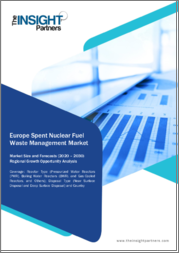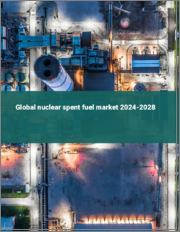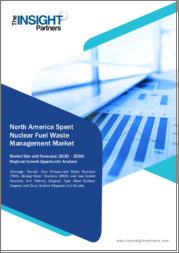
|
시장보고서
상품코드
1510697
유럽의 사용후 핵연료 폐기물 관리 시장 : 시장 예측과 지역별 분석 - 원자로 유형별, 처분 유형별(-2030년)Europe Spent Nuclear Fuel Waste Management Market Forecast to 2030 - Regional Analysis - by Reactor Type and Disposal Type |
||||||
유럽에서 사용후 핵연료 폐기물 관리 시장은 2022년 22억 7,331만 달러에서 2030년에는 17억 2,569만 달러로 성장할 것으로 예상됩니다. 2022-2030년간 CAGR은 -3.4%로 감소할 것으로 추정됩니다.
첨단 핵폐기물 관리 기술의 지속적인 조사와 기술 혁신이 유럽의 사용된 핵연료 폐기물 관리 시장을 견인
대부분의 개발 프로젝트는 자원 기반 극대화와 고수준 폐기물 최소화에 중점을 두고 있기 때문에 핵폐기물 관리의 기술 혁신은 큰 우려를 줄일 수 있습니다. 연구 노력은 수명이 길고 신뢰성과 핵확산 저항성에 새로운 원칙을 제공할 것으로 기대되는 다양한 신세대 원자로(고속로)에서 사용할 수 있는 높은 액티니드 분리에 점점 초점이 맞추어지고 있습니다. 최근의 동향과 이와 관련된 과제는 미래의 원자력 기술에서 첨단 폐기물 관리와 폐로의 역할을 정확하게 이해할 필요성을 보여줍니다. 예를 들어, 사용후 핵연료 폐기물 처분의 혁신적인 기술적 해결책은 심층 처분장의 이용입니다. 깊은 층 처분장은 높은 수준의 방사성 폐기물을 장기간 안전하게 저장할 수 있는 보통 안정적인 암반 지하 깊숙한 곳에 위치한 인공 시설입니다. 깊은 층 처분장은 방사성 폐기물을 생물권으로부터 격리함으로써 더 높은 안전성과 보안을 제공합니다. 이 처분장은 수년간 폐기물을 봉쇄하고 격리하는 암반의 천연 장벽 특성을 활용하여 폐기물 관리에 안정적이고 장기적인 솔루션을 제공합니다. 예를 들어, 핀란드의 Onkalo 처분장은 오르키르오토에 위치해 있으며 고수준 방사성 폐기물을 지표에서 400m 아래의 화강암 암반에 저장하도록 설계되었습니다. Onkalo는 심층 처분의 실현 가능성을 입증합니다. 또한 2022년에는 스웨덴의 Forsmark project가 폐기물 관리를 위한 지하 시설 건설 승인을 얻었습니다. 폴스마르크에 지층처분장을 개발하고, 사용후 핵연료를 유사한 심부지질 조건에 안전하게 수용하는 것을 목적으로 하고 있습니다.
유럽에서 사용후 핵연료 폐기물 관리 시장 개요
유럽에서 사용후 핵연료 폐기물 관리 시장 분석은 프랑스, 스페인, 영국, 독일, 러시아 및 기타 유럽으로 분류됩니다. 유럽의 원자력 발전은 2022년 980.57 TWh를 차지했습니다. 유럽의 일부 국가는 고수준 방사성 폐기물 처분의 잠재적 해결책으로 심층 처분장을 모색하고 있습니다. 특히 핀란드는 사용후 연료를 지하 깊게 저장하는 온칼로 처분장에서 큰 진전을 이루었습니다. 스웨덴도 비슷한 처분장 구상을 하고 있습니다. 그러나 이러한 프로젝트는 현재 진행 중인 규제와 국민 수용의 장애물에 직면하고 있습니다. 유럽연합(EU)에서는 투명성, 안전성, 시민 참여를 중시하고 핵폐기물 관리를 위한 조화된 틀을 확립하려는 움직임이 있습니다. 유럽 국가들은 사용후 핵연료 폐기물을 확보하고 책임감 있게 관리해야 하는 과제에 계속 노력하면서 실행 가능한 장기 처분 솔루션을 모색하고 있으며, 국민의 우려와 규제 요건에 대처하는 것이 중요 성을 인식합니다. 기타 유럽에서 사용후 핵연료 폐기물 관리 시장은 원자력 이용, 정책 결정, 규제 틀의 차이를 반영한 다양한 전략을 특징으로 합니다. 예를 들어, 스웨덴은 중간 저장 시설과 장기 처분을 위한 지층 처분장을 통합하는 종합적인 접근법을 채택합니다. 한편 벨기에는 심층 처분 옵션을 평가하면서 중간 저장 솔루션을 활용합니다. 이러한 폐기물 관리 전략의 촉진요인은 다면적입니다. 에너지 안보는 매우 중요한 역할을 하고 있으며, 많은 유럽 국가들은 에너지 믹스에서 원자력을 중시하고 있습니다. 그 때문에 사용후 핵연료가 축적해, 안전한 저장·처분 방법이 필요하게 됩니다. 엄격한 규제 요건은 안전한 운영과 환경 보호를 보장합니다. 국제 원자력 안전 기준 준수와 마찬가지로 시민 참여와 동의 추구가 필수적입니다. 또한 EU가 폐기물 관리의 조화를 추진하고 국민의 우려에 대처해야 한다는 점도 이 지역의 접근 방식에 영향을 미칩니다.
유럽에서 사용후 핵연료 폐기물 관리 시장의 수익과 2030년까지의 예측(금액)
유럽에서 사용후 핵연료 폐기물 관리 시장의 세분화
유럽에서 사용후 핵연료 폐기물 관리 시장은 원자로 유형, 처분 유형, 국가로 구분됩니다.
원자로 유형에 따라 유럽에서 사용후 핵연료 폐기물 관리 시장은 가압수형 원자로, 끓는 물형 원자로, 가스 냉각형 원자로 등으로 구분됩니다. 가압수형 원자로 부문은 2022년 유럽의 사용된 핵연료 폐기물 관리 시장에서 가장 큰 점유율을 차지했습니다.
폐기 유형에서 유럽의 사용된 핵연료 폐기물 관리 시장은 심층 지표 처분과 근지 표 처분으로 이분됩니다. 2022년 유럽의 사용된 핵연료 폐기물 관리 시장에서는 심층 표면 처분 분야가 큰 점유율을 차지하고 있습니다.
국가별로 보면 유럽에서 사용후 핵연료 폐기물 관리 시장은 독일, 프랑스, 스페인, 러시아, 영국, 기타 유럽으로 구분됩니다. 기타 유럽은 2022년 유럽에서 사용후 핵연료 폐기물 관리 시장을 독점했습니다.
Augean PLC, Perma-Fix, Svensk Karnbranslehantering AB, Ansaldo Energia SPA, Veolia Environnement SA, EnergySolutions는 유럽에서 사용후 핵연료 폐기물 관리 시장에서 사업을 전개하는 대기업의 일부입니다.
목차
제1장 서론
제2장 주요 요약
- 주요 인사이트
- 시장의 매력
제3장 조사 방법
- 조사 범위
- 2차 조사
- 1차 조사
제4장 유럽의 사용후 핵연료폐기물 관리 시장 상황
- 생태계 분석
제5장 유럽의 사용후 핵연료 폐기물 관리 시장- 주요 산업역학
- 사용후 핵연료 폐기물 관리 시장- 주요 산업 역학
- 시장 성장 촉진요인
- 원자력발전소 설립 확대
- 규제 틀과 안전성
- 방사성 폐기물 관리에 있어서의 선별과 분별 자동화 이용 증가
- 시장 성장 억제요인
- 사용후 연료핵폐기물 관리 비용의 불확실성과 불투명성
- 시장 기회
- 고급 방사성 폐기물 관리 기술에 대한 지속적인 조사 및 기술 혁신
- 향후의 동향
- 장래의 에너지 전환에 있어서의 원자력의 중요한 역할
- 성장 촉진요인과 억제요인의 영향
제6장 사용후 핵연료 폐기물 관리 시장-유럽 시장 분석
- 유럽의 사용후 핵연료 폐기물 관리 시장의 매출액, 2020-2030년
- 유럽의 사용후 핵연료 폐기물 관리 시장 예측과 분석
제7장 유럽의 사용후 핵연료 폐기물 관리 시장 분석 : 원자로 유형별
- 가압수형 원자로
- 가압수형 원자로시장, 2030년까지의 수익과 예측
- 끓는 물형 원자로
- 끓는 물형 원자로 시장, 수익과 2030년까지의 예측
- 가스 냉각로
- 가스 냉각로 시장, 수익과 2030년까지의 예측
- 기타
- 기타 시장, 수익과 2030년까지의 예측
제8장 유럽의 사용후 핵연료 폐기물 관리 시장 분석 : 처분 유형별
- 지표처분
- 지표처분 시장, 수익과 2030년까지의 예측
- 심층처분
- 심층처분 시장, 수익과 2030년까지의 예측
제9장 유럽의 사용후 핵연료폐기물 관리 시장 : 국가별 분석
- 유럽
- 독일
- 프랑스
- 스페인
- 러시아
- 영국
- 기타 유럽
제10장 업계 정세
- 시장 이니셔티브
- 합병과 인수
제11장 기업 프로파일
- Augean PLC
- Perma-Fix
- Svensk Krnbrnslehantering AB
- Ansaldo Energia SPA
- Veolia Environnement SA
- EnergySolutions
제12장 부록
JHS 24.07.24The Europe spent nuclear fuel waste management market is expected to grow from US$ 2,273.31 million in 2022 to US$ 1,725.69 million by 2030. It is estimated to decline at a CAGR of -3.4% from 2022 to 2030.
Ongoing Research and Innovation on Advanced Nuclear Waste Management Technologies Drives Europe Spent Nuclear Fuel Waste Management Market
Innovations in nuclear waste management can alleviate a major concern as most development projects focus on maximizing the resource base and minimizing high-level waste. Research efforts are increasingly focused on the separation of higher actinides that are long-lived and can be used in a range of new-generation reactors (fast reactors) that are expected to offer new principles in reliability and proliferation resistance. Recent developments and associated challenges demonstrate the need to gain a sound understanding of the role of advanced waste management and decommissioning in future nuclear technologies. For example, an innovative technical solution for spent nuclear fuel waste disposal is the use of deep geological repositories. Deep geological repositories are engineered facilities located deep underground, typically in stable rock formations, where high-level nuclear waste can be safely stored for extended periods. Deep geological repositories offer enhanced safety and security by isolating the radioactive waste from the biosphere. These repositories capitalize on the natural barrier properties of the rock formations to contain and isolate the waste for years, providing a reliable, long-term solution for waste management. For example, Finland's Onkalo repository is situated in Olkiluoto and is designed to store high-level waste in granite bedrock 400m below the surface. Onkalo is a testament to the feasibility of deep geological disposal. In addition, in 2022, Sweden's Forsmark project got approval for construction of underground facility for waste management. It aims to develop a geological repository in Forsmark to house spent nuclear fuel in similar deep geological conditions safely.
Europe Spent Nuclear Fuel Waste Management Market Overview
The Europe spent nuclear fuel waste management market analysis is categorized into France, Spain, the UK, Germany, Russia, and the Rest of Europe. Nuclear power generation in Europe accounted for 980.57 TWh in 2022. Several European countries have explored deep geological repositories as a potential solution for high-level nuclear waste disposal. Notably, Finland has made significant progress with its Onkalo repository, where spent fuel will be stored deep underground. Sweden is also working on a similar repository concept. However, these projects face ongoing regulatory and public acceptance hurdles. In the European Union, there is a push to establish a harmonized framework for managing nuclear waste, emphasizing transparency, safety, and public engagement. European nations continue to grapple with the challenge of securing and responsibly managing spent nuclear fuel waste while seeking viable long-term disposal solutions, recognizing the importance of addressing public concerns and regulatory requirements. The spent nuclear fuel waste management market in the Rest of Europe is characterized by diverse strategies, reflecting variations in nuclear energy usage, policy decisions, and regulatory frameworks. For instance, Sweden has adopted a comprehensive approach, incorporating interim storage facilities and geological repositories for long-term disposal. Belgium, on the other hand, utilizes interim storage solutions while evaluating deep geological repository options. The driving factors behind these waste management strategies are multifaceted. Energy security plays a pivotal role, with many European nations emphasizing nuclear power in their energy mix. This leads to the accumulation of spent nuclear fuel and a need for secure storage and disposal methods. Strict regulatory requirements ensure safe practices and environmental protection. Public engagement and consent-seeking are essential, as is compliance with international nuclear safety standards. Additionally, the EU's push for harmonized waste management and the need to address public concerns further influence the region's approach.
Europe Spent Nuclear Fuel Waste Management Market Revenue and Forecast to 2030 (US$ Million)
Europe Spent Nuclear Fuel Waste Management Market Segmentation
The Europe spent nuclear fuel waste management market is segmented into reactor type, disposal type, and country.
Based on reactor type, the Europe spent nuclear fuel waste management market is segmented into pressurized water reactor, boiling water reactor, gas cooled reactor, and others. The pressurized water reactor segment held the largest share of the Europe spent nuclear fuel waste management market in 2022.
In terms of disposal type, the Europe spent nuclear fuel waste management market is bifurcated into deep surface disposal, and near surface disposal. The deep surface disposal segment held a larger share of the Europe spent nuclear fuel waste management market in 2022.
Based on country, the Europe spent nuclear fuel waste management market is segmented into Germany, France, Spain, Russia, the UK, and the Rest of Europe. The Rest of Europe dominated the Europe spent nuclear fuel waste management market in 2022.
Augean PLC, Perma-Fix, Svensk Karnbranslehantering AB, Ansaldo Energia SPA, Veolia Environnement SA, and EnergySolutions are some of the leading companies operating in the Europe spent nuclear fuel waste management market.
Table Of Contents
Table of Content
1. Introduction
- 1.1 The Insight Partners Research Report Guidance
- 1.2 Market Segmentation
2. Executive Summary
- 2.1 Key Insights
- 2.2 Market Attractiveness
3. Research Methodology
- 3.1 Coverage
- 3.2 Secondary Research
- 3.3 Primary Research
4. Europe Spent Nuclear Fuel Waste Management Market Landscape
- 4.1 Overview
- 4.2 Ecosystem Analysis
5. Europe Spent Nuclear Fuel Waste Management Market - Key Industry Dynamics
- 5.1 Spent Nuclear Fuel Waste Management Market - Key Industry Dynamics
- 5.2 Market Drivers
- 5.2.1 Growing Establishment of Nuclear Power Plants
- 5.2.2 Regulatory Framework and Safety
- 5.2.3 Rising Use of Automation in Sorting and Segregation of Nuclear Waste Management
- 5.3 Market Restraints
- 5.3.1 Uncertainty and Unclarity in Cost of Spent Fuel Nuclear Waste Management
- 5.4 Market Opportunities
- 5.4.1 Ongoing Research and Innovation on Advanced Nuclear Waste Management Technologies
- 5.5 Future Trends
- 5.5.1 Key Role of Nuclear Power in Future Energy Transition
- 5.6 Impact of Drivers and Restraints:
6. Spent Nuclear Fuel Waste Management Market - Europe Market Analysis
- 6.1 Europe Spent Nuclear Fuel Waste Management Market Revenue (US$ Million), 2020 - 2030
- 6.2 Europe Spent Nuclear Fuel Waste Management Market Forecast and Analysis
7. Europe Spent Nuclear Fuel Waste Management Market Analysis - Reactor Type
- 7.1 Overview
- 7.1.1 Europe Spent Nuclear Fuel Waste Management Market, By Reactor Type (2022 and 2030)
- 7.2 Pressurized Water Reactor
- 7.2.1 Overview
- 7.2.2 Pressurized Water Reactor Market, Revenue and Forecast to 2030 (US$ Million)
- 7.3 Boiling Water Reactor
- 7.3.1 Overview
- 7.3.2 Boiling Water Reactor Market, Revenue and Forecast to 2030 (US$ Million)
- 7.4 Gas Cooled Reactor
- 7.4.1 Overview
- 7.4.2 Gas Cooled Reactor Market, Revenue and Forecast to 2030 (US$ Million)
- 7.5 Others
- 7.5.1 Overview
- 7.5.2 Others Market, Revenue and Forecast to 2030 (US$ Million)
8. Europe Spent Nuclear Fuel Waste Management Market Analysis - Disposal Type
- 8.1 Overview
- 8.1.1 Spent Nuclear Fuel Waste Management Market, By Disposal Type (2022 and 2030)
- 8.2 Near Surface Disposal
- 8.2.1 Overview
- 8.2.2 Near Surface Disposal Market, Revenue and Forecast to 2030 (US$ Million)
- 8.3 Deep Surface Disposal
- 8.3.1 Overview
- 8.3.2 Deep Surface Disposal Market, Revenue and Forecast to 2030 (US$ Million)
9. Europe Spent Nuclear Fuel Waste Management Market - Country Analysis
- 9.1 Europe
- 9.1.1 Europe Spent Nuclear Fuel Waste Management Market Overview
- 9.1.2 Europe Spent Nuclear Fuel Waste Management Market, By Key Country, Revenue 2022 (US$ Mn)
- 9.1.3 Europe Spent Nuclear Fuel Waste Management Market Revenue and Forecasts and Analysis - By Country
- 9.1.3.1 Europe Spent nuclear Fuel Waste Management Market Revenue and Forecasts and Analysis - By Country
- 9.1.3.2 Germany Spent Nuclear Fuel Waste Management Market Revenue and Forecasts to 2030 (US$ Mn)
- 9.1.3.2.1 Germany Spent Nuclear Fuel Waste Management Market Breakdown by Reactor Type
- 9.1.3.2.2 Germany Spent Nuclear Fuel Waste Management Market Breakdown by Disposal Type
- 9.1.3.3 France Spent Nuclear Fuel Waste Management Market Revenue and Forecasts to 2030 (US$ Mn)
- 9.1.3.3.1 France Spent Nuclear Fuel Waste Management Market Breakdown by Reactor Type
- 9.1.3.3.2 France Spent Nuclear Fuel Waste Management Market Breakdown by Disposal Type
- 9.1.3.4 Spain Spent Nuclear Fuel Waste Management Market Revenue and Forecasts to 2030 (US$ Mn)
- 9.1.3.4.1 Spain Spent Nuclear Fuel Waste Management Market Breakdown by Reactor Type
- 9.1.3.4.2 Spain Spent Nuclear Fuel Waste Management Market Breakdown by Disposal Type
- 9.1.3.5 Russia Spent Nuclear Fuel Waste Management Market Revenue and Forecasts to 2030 (US$ Mn)
- 9.1.3.5.1 Russia Spent Nuclear Fuel Waste Management Market Breakdown by Reactor Type
- 9.1.3.5.2 Russia Spent Nuclear Fuel Waste Management Market Breakdown by Disposal Type
- 9.1.3.6 UK Spent Nuclear Fuel Waste Management Market Revenue and Forecasts to 2030 (US$ Mn)
- 9.1.3.6.1 UK Spent Nuclear Fuel Waste Management Market Breakdown by Reactor Type
- 9.1.3.6.2 UK Spent Nuclear Fuel Waste Management Market Breakdown by Disposal Type
- 9.1.3.7 Rest of Europe Spent Nuclear Fuel Waste Management Market Revenue and Forecasts to 2030 (US$ Mn)
- 9.1.3.7.1 Rest of Europe Spent Nuclear Fuel Waste Management Market Breakdown by Reactor Type
- 9.1.3.7.2 Rest of Europe Spent Nuclear Fuel Waste Management Market Breakdown by Disposal Type
10. Industry Landscape
- 10.1 Overview
- 10.2 Market Initiative
- 10.3 Merger and Acquisition
11. Company Profiles
- 11.1 Augean PLC
- 11.1.1 Key Facts
- 11.1.2 Business Description
- 11.1.3 Products and Services
- 11.1.4 Financial Overview
- 11.1.5 SWOT Analysis
- 11.1.6 Key Developments
- 11.2 Perma-Fix
- 11.2.1 Key Facts
- 11.2.2 Business Description
- 11.2.3 Products and Services
- 11.2.4 Financial Overview
- 11.2.5 SWOT Analysis
- 11.2.6 Key Developments
- 11.3 Svensk Krnbrnslehantering AB
- 11.3.1 Key Facts
- 11.3.2 Business Description
- 11.3.3 Products and Services
- 11.3.4 Financial Overview
- 11.3.5 SWOT Analysis
- 11.3.6 Key Developments
- 11.4 Ansaldo Energia SPA
- 11.4.1 Key Facts
- 11.4.2 Business Description
- 11.4.3 Products and Services
- 11.4.4 Financial Overview
- 11.4.5 SWOT Analysis
- 11.4.6 Key Developments
- 11.5 Veolia Environnement SA
- 11.5.1 Key Facts
- 11.5.2 Business Description
- 11.5.3 Products and Services
- 11.5.4 Financial Overview
- 11.5.5 SWOT Analysis
- 11.5.6 Key Developments
- 11.6 EnergySolutions
- 11.6.1 Key Facts
- 11.6.2 Business Description
- 11.6.3 Products and Services
- 11.6.4 Financial Overview
- 11.6.5 SWOT Analysis
- 11.6.6 Key Developments
12. Appendix
- 12.1 About the Insight Partners
- 12.2 Word Index



















